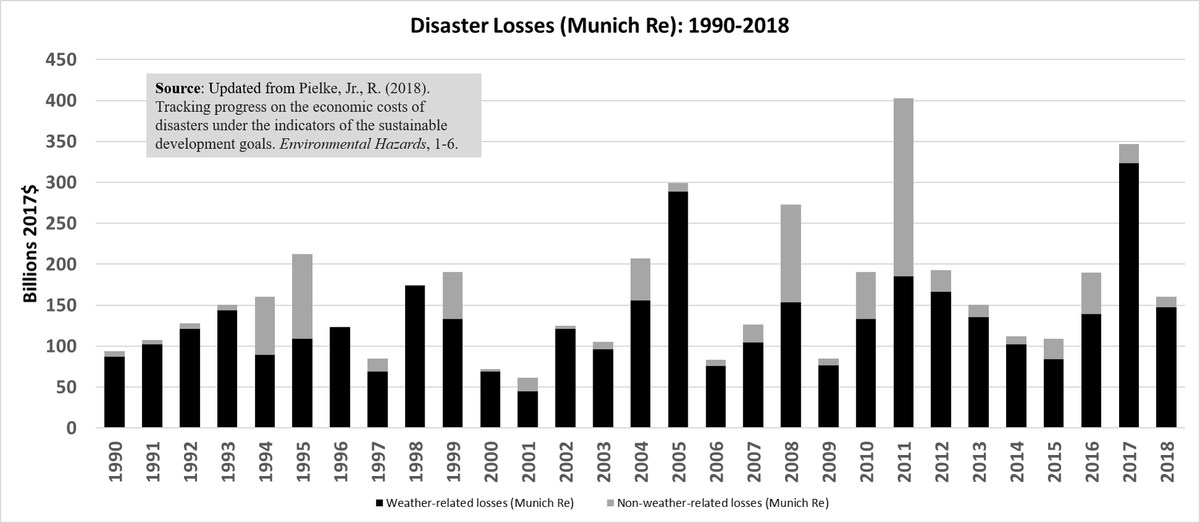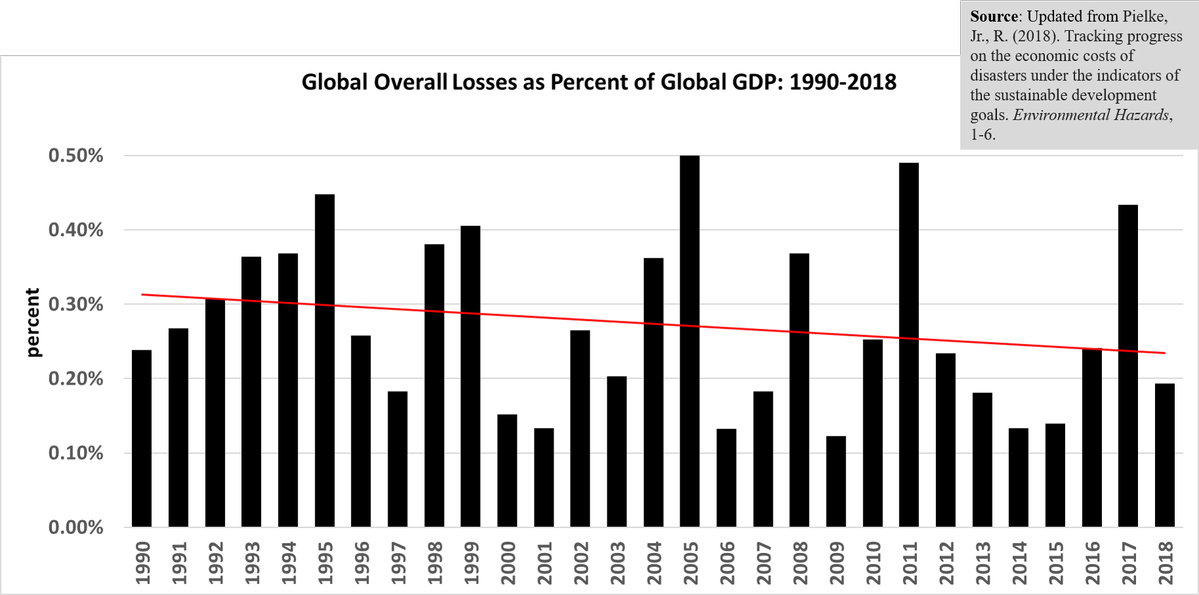
The figure above shows disaster losses as tracked by Munich re from 1900 to 2018, based on an update published earlier this week (here). The update allows me to add another year to the data reported in this paper:
Pielke, R. (2018). Tracking progress on the economic costs of disasters under the indicators of the sustainable development goals. Environmental Hazards, 1-6.
The graphs below show losses as a percentage of global GDP from 1990 to 2018, for all catastrophes (top) and those that are weather/climate related (bottom)


- Overall losses were at about the 1990-2017 average ($160b vs $163b)
- Weather/Climate losses were above the 1990-2017 average ($147B vs $129B)
- Overall losses are well below the 1990-2017 average (0.19% vs 0.28%)
- Weather/Climate losses are slightly below 1990-2017 average (0.18% vs 0.22)
Bottom line:
- 2018 saw substantial disasters with large costs.
- However, in terms of economic damage it was a fairly typical year in historical context.
- 2018 contributes to the trend (1990-2018) of disaster losses decreasing as a proportion of global GDP.
This is good news.

It’d be nice to also see weather-related fatalities . . .
LikeLike
[…] https://rogerpielkejr.com/2019/01/10/tracking-progress-on-disasters-2018-update/ […]
LikeLike
[…] Read more at Roger Pielke Jr. […]
LikeLike
Reblogged this on WeatherAction News and commented:
Damn this is not going to generate clicks. The media demand their #DisasterPorn narrative
LikeLike
So are we seeing a trend of GDP increase or the human toll of natural disasters? Why approach it that way? The parabolic rise in GDP will mask the true toll that disasters inflict.
Accounting methods versus human cost…nice trick.
LikeLike
No. It would be deceitful trickery if the damage weren’t normalized.
LikeLike
When the nascent upward trend of the unadjusted toll overtakes global GDP gains, the chart will need to be re-scaled…otherwise a new “normal” might become inescapable. Grand solar minimums tend to do that.
Gross World Product — not all it’s portrayed as.
https://www.imf.org/external/datamapper/NGDP_RPCH@WEO/WEOWORLD
LikeLike
[…] https://rogerpielkejr.com/2019/01/10/tracking-progress-on-disasters-2018-update/ […]
LikeLike
[…] https://rogerpielkejr.com/2019/01/10/tracking-progress-on-disasters-2018-update/ […]
LikeLike
[…] Disasters Under the Indicators of the Sustainable Development Goals, Environmental Hazards. (Note: Here is an update of the data through […]
LikeLike
[…] Munich Re data, University of Colorado political scientist Roger Pielke, Jr. calculates that the trend of weather disaster losses, as a percentage of global GDP, trended downward from 1990 to 2018. As global GDP rises, absolute […]
LikeLike
[…] Munich Re data, University of Colorado political scientist Roger Pielke, Jr. calculates that the trend of weather disaster losses, as a percentage of global GDP, trended downward from 1990 to 2018. As global GDP rises, absolute […]
LikeLike
[…] Munich Re data, University of Colorado political scientist Roger Pielke, Jr. calculates that the trend of weather disaster losses, as a percentage of global GDP, trended downward from 1990 to 2018. As global GDP rises, absolute […]
LikeLike